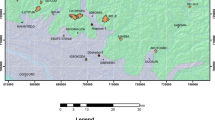Abstract
The ostracode fauna across the Paleocene/Eocene boundary has been studied at 5 m intervals between 690–810 m in the Ghotaru Fort Well (GTF Well-A), Jaisalmer Basin, Rajasthan. Ostracodes and foraminifera have been utilized to provide the biostratigraphic framework. Four ostracode zones designated as POS-I to POS-IV in the Late Paleocene and one zone EOS-I in the earliest Early Eocene age sediments have been recognized. Quantitative ostracode and qualitative foraminiferal data were used to interpret the paleoenvironment across the Paleocene/Eocene boundary. Occurrence of the benthic foraminiferaDiscocyclina seunesi andMiscellanea miscella at 735–740 m depth in this well suggests a latest Late Paleocene age. The frequency and diversity of ostracodes at this depth is low. The ostracodes recorded near the top of the Paleocene are:Anommatocytkere indica, Echinocythereis contexta, Phyrocythere alfuraihi andSchizocythere prolata. This ostracode assemblage along with benthic foraminifera suggests that sediments were deposited in an inner neritic environment. This is followed by an earliest Early Eocene age transgression marked by the extinction of preceding Late Paleocene ostracodes and advent of a new ostracode suite represented byAlocopocythere abstracta in the 725–730 m interval. In the 720–725 m interval, however, there is a turnover to an entirely new suite of ostracodes represented byParagrenocythere reticulospinosa, Phalcocythere sentosa, Hornibrookella avadheshi, H. jaisalmerensis, Alocopocythere abstracta, Gyrocytbere parvicarinata, Schizocythere appendiculata, Bairdoppilata kalakotensis, Uroleberis khoslai, Loxoconchella ? guhai, Cytherella jaisalmerensis andC. tawaica. This ostracode assemblage is indicative of Early Eocene age and deposition in an inner neritic environment. The Paleocene/Eocene boundary in well GTF-A is recognised on the basis of ostracodes and foraminifera at 735–740 m, which in turn coincides with an overall sea level fall attributed to global warming, and this is further corroborated by a negative carbon excursion (δ13C=−13.63) across the Paleocene/Eocene boundary.
Similar content being viewed by others
References
Berggren, W.A., Kent, D.V., Swisher, C.C. &Aubry, M.-P. (1995): A revised Cenozoic geochronology and chronostratigraphy. — In:Berggren, W.A.,Kent, D.V.,Swisher, C.C,Aubry, M.-P. &Hardenbol, J. (Eds): Geochronology, time Scales and Global Stratigraphic correlation. — SEPM Special Publication,54:129–212.
Berggren, W.A. &Ouda, K. (2003): Upper Paleocene-Lower Eocene planktonic foraminiferal biostratigraphy of the Arabia section, upper Nile Valley (Egypt). — Micropaleontology,49 (Supp. 10): 61–92.
Berggren, W.A. &Pearson, P. (2005): A revised tropical to subtropical Paleogene planktonic foraminiferal zonation. — Journal of Foraminiferal Research,35 (4): 279–298.
Bhandari, A. (1991): Late Eocene Ostracoda from the Jaisalmer Basin, Rajasthan. — Paleontological Society of India,36: 43–49.
Bhandari, A. (1992): Late Paleocene Ostracoda from the subsurface of Jaisalmer Basin, Rajasthan. — Geoscience Journal,XIII (1): 39–75.
Bhandari, A. (1995a): Early Eocene ostracodes from the subsurface of Jaisalmer Basin, Rajasthan. Geoscience Journal,XV (1): 73–99.
Bhandari, A. (1995b): Ostracoda biozonation from subsurface of Jaisalmer, Rajasthan. — Proceedings Twelfth International Symposium on Ostracoda, Prague: 183–192.
Bhandari, A. (1996): Atlas of Paleogene ostracodes of Rajasthan basins. Paleontographica Indica no.4, Geoscience Research Group, KDMIPE, ONGC: 1–153. Dehradun, (Kdmipe).
Bhandari, A. &Raju, D.S.N. (1991): Tertiary sea level changes and transgressive/regressive cycles in Cambay, Kutch and Rajasthan basins: A review. — In:Pandey, J. &Banerjee, V (Eds): Proceedings, Conference on Integrated Exploration Research, Achievements and Perspectives: 169–177. Dehradun, (KDMIPE).
Bhandari, A., Singh H. &Rana, R.S. (2005): A note on occurrence of ostracodes from the Vastan Lignite Mine, Gujarat. — Paleontological Society of India,50 (1): 141–146.
Khosla, S.C. &Pant, P.C. (1988): Ostracoda from the Eocene and Oligocene beds of Kachchh, Gujarat, part-I, families Cytherellidae, Bairdiidae and Trachyleberididae. — Indian Journal of Earth Science,15 (4): 325–346.
Misra, P.C.,Singh, N.P.,Sharma, D.C.,Upadhyay, H.,Kakroo, A.K. &Saini, M.L. (1993): Lithostratigraphy of West Rajasthan basins. — ONGC report (unpublished).
Siddiqui, Q.A. (1971): Early Tertiary Ostracoda of the family Trachyleberididae from west Pakistan. — British Museum (Natural History.), Bull. Suppl.9: 1–98.
Singh, N.P. (1984): Addition to the Tertiary biostratigraphy of Jaisalmer Basin. — Petroleum Asia Journal,1984: 106–128.
Sluijs, A.,Bowen, G. J.,Brinkhuis, H.,Lourens, L. J., &Thomas, E. (In-press, Preprint): The Palaeocene-Eocene Thermal Maximum super greenhouse: biotic and geochemical signatures, age models and mechanisms of climate change. — In: Deep Time Perspectives on Climate Change. — Geological Society of London Special Publication.
Zachos, J.C., Lohmann, K.C., Walker, J.C.G. &Wise, S.W. (1993): Abrupt climate change and transient climates during the Paleogene: a marine perspective. — Journal of Geology,101: 191–213.
Author information
Authors and Affiliations
Rights and permissions
About this article
Cite this article
Bhandari, A. Ostracode biostratigraphy and carbon and oxygen isotopic studies across the Paleocene/Eocene boundary in the subsurface of Jaisalmer Basin, Rajasthan, India. Senckenbergiana lethaea 88, 67–76 (2008). https://doi.org/10.1007/BF03043979
Received:
Revised:
Issue Date:
DOI: https://doi.org/10.1007/BF03043979



